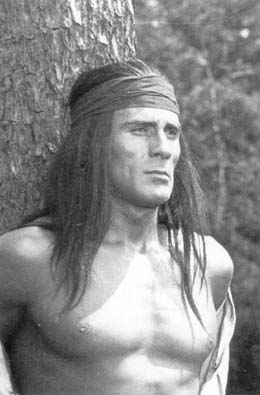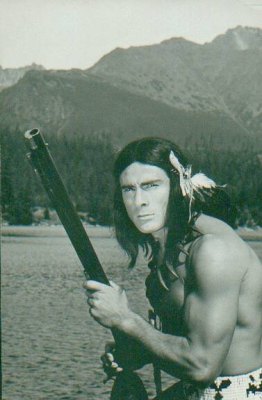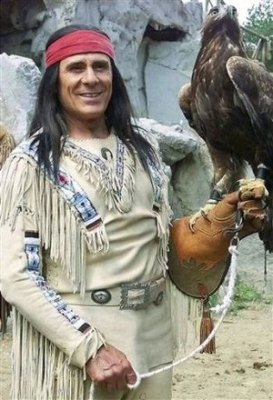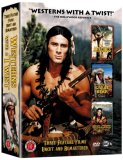| Reviews & Columns |
|
Reviews DVD TV on DVD Blu-ray 4K UHD International DVDs In Theaters Reviews by Studio Video Games Features Collector Series DVDs Easter Egg Database Interviews DVD Talk Radio Feature Articles Columns Anime Talk DVD Savant Horror DVDs The M.O.D. Squad Art House HD Talk Silent DVD
|
DVD Talk Forum |
|
|
| Resources |
|
DVD Price Search Customer Service #'s RCE Info Links |
|
Columns
|
|
|
Westerns with a Twist
In the early 1960s, the Communist East German cinema was struggling. Tied down by ideological constraints mandated by the socialist government, many of the productions of the German Democratic Republic were either unsuccessful with audiences because of their pedantic, stilted execution, or they were heavily censored or suppressed because of perceived political heresy in their content. On the other side of the Iron Curtain, West German cinema was booming, churning out popular (if uninspired) entertainment to receptive audiences. A particularly strong genre in the West German cinema was, ironically enough, that most American of film genres: the Western. Karl May, the Wild West writer, was (and indeed may still be) the best selling author in Germany. His fanciful tales of America's West were generated not by first-hand experience (he never even visited America until he had already stopped writing westerns), but by pouring over history books and maps, as well as by doing what most authors of fiction do: making it up as he went along. His romanticized novels, featuring many "noble savage" Indians as protagonists, captured the hearts of Germans everywhere during his lifetime, creating a strong myth concerning the history of America's West that viewed the Indian in a much more sympathetic light than might be found in many similar "penny dreadfuls" published here in America.

Searching for a way to become more profitable (an irony apparently not acknowledged by a studio controlled by the Socialist Unity Party), the German Democratic Republic's state-sponsored studio, DEFA, looked around to see what movies were making money in West Germany, and they happened upon the Western film. Choosing to make a Western satisfied many goals of DEFA, and by extension, the GDR that controlled the studio. First, they hoped to make some money because their other films were bombing financially. Second, a hit film conveys status on a studio, and DEFA hoped to elevate itself in the eyes of indifferent East German audiences. And third, utilizing a unique American film genre presented possibilities to spread anti-American propaganda to international audiences (specifically by illustrating a shameful period of American expansion into Indian land), while at the same time, promoting socialist ideals through film. In essence, the Communists were going to beat the Americans at their own game.
The first Indianerfilme for DEFA was The Sons of The Great Bear, in 1965. In the Black Hills of South Dakota, gold fever is sweeping through the land. Mattotaupa, Chief of the Bear Tribe of the Great Sioux Nation, is murdered by his "son," Fred Clarke, also known as Red Fox. Clarke, a white man, has taken advantage of his relationship with Mattotaupa to find out where the tribe's sacred gold is stashed. When Mattotaupa refuses to say which mountain the gold is located in, Red Fox kills him in front of his son, Tokei-itho. Major Smith and Lieutenant Roach want the railroads to keep coming into Indian land (against the Fort Laramie Treaty of 1868) so gold mining can continue unabated. The Army, with U.S. government approval, decrees that the Indians should be moved onto reservations. Tokei-itho rejects this notion, and tries to unite the various Indian tribes, parlaying with Tashunka-witko (Crazy Horse) to resist the white man. After an initial skirmish, Tokei-itho comes to Fort Smith to smoke the peace pipe with Major Smith. However, Lieutenant Roach tries to kill Tokei-itho, who escapes, but not before he blows up the saloon where his father was fatally stabbed.
When the Army seeks Red Fox's advice, he counsels negotiation, and he goes to Tokei-itho's tribe to try and parlay for peace. He convinces the elderly chief that the whites mean no harm, but Tokei-itho distrusts him. Against his better judgment, Tokei-itho goes back to the fort to formally negotiate the move to the reservation for his tribe. However, Roach has other plans, and holds Tokei-itho against his will. Eventually, after Major Smith dies, Roach is ordered to release Tokei-itho. His tribe has suffered badly at the inhospitable reservation, and despite Red Fox's entreaty to go in together as partners, Tokei-itho returns to his tribe to lead them off the reservation. After a fateful encounter with their Great Mother Bear in her cave, Tokei-itho decides that his tribe will cross the Missouri River to farm with Adamson, a sympathetic white who earlier offered his friendship to Tokei-itho. However, Red Fox and the Army try to stop the Sioux from leaving, and in the climactic ending, Tokei-itho and Red fight to the death.
The Sons of The Great Bear has often been called a "groundbreaking" Western film because it started a cycle of DEFA films that put the Indians as heroes, and the white man and the U.S. government as the villain. I reject that notion. True, many early Hollywood films treated Indians as nothing more than cartoon villains embodying the worst kind of racial stereotypes. However, a careful reading of Hollywood Westerns reveal an infinitely more complex view of White/Indian relations, with not all Westerns as black and white in their Indian portrayals as some historians would have you believe. Even a racist, minor Shirley Temple Western like Susannah of the Mounties contained Indian and white characters that traded traditional film roles found in Hollywood Westerns, as well as showing business concerns (the railroad) effecting Army and government policy. And by the early 1950s, with the beginnings of the civil rights movement already formed in America, Hollywood started to take its most socially malleable genre, the Western, and infuse those films with the same growing pains and complexities that marked this country's (continued) civil rights struggle. So by 1965, I don't believe that The Sons of The Great Bear was that groundbreaking in its portrayal of America's Western past.
Politics aside, The Sons of The Great Bear viewed strictly in terms of a commercially viable action film (which is fair, considering that was the one of the main goals of its production), suffers in comparison to its Hollywood and Italian cousins. It's a fairly lugubrious Western, directed by Josef Mach, with much exposition for the ears, and little action for the eyes. And what action there is, is inept in comparison to our average Hollywood Westerns of the time. The first major action scene, which is an Indian attack on a wagon train, sports hesitant action, plenty of visible trip wires for the horses, the same shots used several times, and exceedingly poor music cues. In fact, the music (provided by Wilhelm Neef) throughout The Sons of The Great Bear is quite bizarre at times, including the first idyllic visit to the Indian village (read: socialist collective here) that includes what can only be described as a combination of cocktail/romantic comedy music, complete with clarinets and electric guitars. The acting is somewhat stilted, as well. Serbian actor Gojko Mitic, who arguably was the most popular actor in East Germany, comes across somewhat like an early (and later) Charles Bronson. He's physically perfect for the part, looking incredibly fit and tough; he's the very picture of an action hero. But his emoting and line delivery (even in German to this ear) lack much nuance. Jiri Vrstala is quite good, though, as Red Fox. With his shaded performance, he could fit into a Leone Western quite easily. Another plus of The Sons of The Great Bear is the sensational cinematography. According to notes on the DVD, it was filmed largely in the Montenegro and Elbsandsteingebirge areas of former East Germany, and the scenery is spectacular.

Evidently, DEFA had no idea that The Sons of The Great Bear would be the smash hit it turned out to be; released during the summer months, it created a real sensation with audiences who demanded more Westerns that not only keyed into the long love affair that Germany had with the American Indian, but that also offered pungent anti-American propaganda. DEFA would immediately follow up The Sons of The Great Bear with Chingachgook: The Great Snake.
Chingachgook: The Great Snake is based on the James Fenimore Cooper's Indian character from his Leatherstocking Tales story, The Deerslayer. In 1740, prior to outright war breaking out between English and French troops in the American colonies, the Huron and Delaware Indian tribes increasingly scuffle, due to (the film tells us) the English exploiting the conflict in order to wipe out all the tribes. The Hurons aid the French, and the Delawares work for the English, but that makes no difference to English Captain Warley (Horst Preusker), who desires to have the Indians battle each other before the war with the French starts. Officer Thornton (Karl Zugowski) counters that the Delaware are their allies, and that the British Crown wants justice and peace for all of its subjects - regardless of their race. Warley laughs and tells Thornton that the only thing the Crown wants is money.Chingachgook (Gojko Mitic) meanwhile is being celebrated in the Delaware tribe for returning their wounded chief from the Huron. Even though he is the last surviving member of the Mohican tribe, he is to be awarded Wahtawah (Andrea Drahota), a beautiful Delaware maiden. However, she is kidnapped by the Huron, and Chingachgook and his friend Deerslayer (Rolf Romer), go to look for her. On their way, Deerslayer runs into acquaintance Harry Hurry (Jurgen Frohriep), a racist killer who wants to hunt Indian scalps for the bounty offered by the English. Taking refuge on a floating cabin on the lake, Deerslayer and Harry met its owner, Tom Hutter (Helmut Schreiber), who, with his daughter, Judith (Lilo Grahn), has successfully outwitted the hostile Indians for years.
Ducking out on Deerslayer, whom they feel is too sympathetic to Indians, Harry and Tom go out to gather Huron scalps - regardless of whether they happen to be Indian women or children. They try to capture Wahtawah, but they instead are captured. Deerslayer enlists Chingachgook's help in finding the key to Tom's treasure chest; there they find several carved elephants, which they use as powerful "magic" to barter for Tom and Harry's lives. Unfortunately, after the trade, Harry shoots at the departing Hurons, causing the Hurons to flare up, and declare war on the whites. In the process, Chingachgook is captured by the Hurons, and must endure a series of tests to determine his bravery. Just as the Hurons accept Chingachgook as one of their own, the British come and lay waste to the Huron tribe. As the Chief lays wounded, he asks his tribe to join as one against the whites. Deerslayer and Chingachgook go off together, after Deerslayer rejects Judith's offer to stay with her.
Chingachgook: The Great Snake is certainly the weakest entry here in the Westerns with a Twist box set. Relying heavily on interior sets for outdoor scenes, it often looks like our American TV Westerns; the British Fort set is seriously cramped, looking like a bad pick-up shot for the Daniel Boone show. Almost all of the outdoor scenes are shot indoors, with big, heavy fake trees and painted backdrops. As well, there are several ridiculously choreographed Indian dances appearing throughout the film, that fail to register in any way as authentic. The film opens with an unconvincing dance, setting the tone for this poor Western. Particularly bad is the war dance the Hurons have when they declare the peace broken after Harry's rifle shot: chaotic gyrations with spotty dance technique equals a badly produced Seven Indian Brides for Seven Indian Brothers spoof. The action again is poorly staged, including a pointlessly overblown sequence where Chingachgook steals a horse for no apparent reason. The sequence culminates in Mitic jumping up and grabbing a tree branch, a tiny little stunt I've seen a hundred times before in Hollywood Westerns, going back to the teens. But with the way the filmmakers swell up the inappropriate music over this action piece, you'd think you were watching the chariot race in Ben-Hur.Of course, no DEFA Indianerfilme film would be complete without the obligatory slam against capitalism and American/European/bourgeois racism, so the film opens with a narrator lecturing the audience on the economic dependency that the Europeans "forced" on the Indians. With the film asserting that the Indians were too naive to understand the value of their goods, it essentially equates Indians with simple children at the mercy of the scheming white race - a racist viewpoint towards Indians as well as whites. As well, the film asserts that the British "taught" the Indians to hate each other, an incredibly simplistic reading of history that isn't born out by the facts. When it looks like the film might actually play fair with the facts during a scene where Deerslayer and Judith discuss scalping, with Judith asserting that whites didn't invent scalping, Deerslayer counters with "We may not have invented it, but we made it a business," as if that point of degree makes one implementation of that horrendous practice okay, and the other not. Of course, the depiction of Indians in Chingachgook: The Great Snake plays into the now-thoroughly debunked, racist notion of the "noble savage," a concept from the Romantic period that asserted certain cultures as inherently better because of their lack of contact with so-called civilized societies. Chingachgook: The Great Snake is a poor action film, and an unconvincing political tract.
Rounding out the Westerns with a Twist box set is another Gojko Mitic-starring vehicle, and it's certainly the best of the bunch. Apaches, released in 1973, was the result of slow-down in the Indianerfilme cycle. According to an interview with Mitic on this disc, Apaches came about because Mitic decided he needed to generate his own projects to stay busy. He co-wrote this film, and helped craft an entertaining actioner.
Prior to Invitation Day, which is a yearly party for Apaches and Mexicans courtesy of the mining company that operates on Mexican land negotiated away from the Apaches, Ulzana (Mitic) decides to attend the festivities. He wants to see the "peace" that was negotiated, that decimated his tribe and made a drunken, dependant fool of his father. At the festival, Johnson (Milan Beli), an American geologist, confers with Ramon (Leon Niemczyk), the Mexican overseer of the mine, on their plan to massacre all of the Mexicans and Indians who attend the party. When push comes to shove, after Ramon expresses doubt about the plan, Johnson tells Ramon that the mine wants more copper and more gold, and they'll kill anyone (with the covert aid of the U.S. Army) who stands in their way. When Ramon protests that Johnson is standing on Mexican land, Johnson counters that Ramon is standing on former Apache land.
Ulzana watches the party carefully, and realizes something is wrong. He manages to escape with his life when most of the partygoers are either blown up or mowed down with gunfire. As Ulzana flees, Johnson dictates which scalps will be taken from the dead. What follows is a back-and-forth battle between Johnson's forces and Ulzana, with a final, deadly confrontation between the two while their men fight as well.
Clearly, someone at DEFA saw a Sergio Leone or Sam Peckinpah film prior to starting Apaches, and it's all the better for that influence. The opening of Apaches is pure Leone: extremely long-distance shots with telephoto lens, alternating with extreme closeups, while discordant music plays on the soundtrack. There's a modern, violent feel to Apaches that's missing from the first two films that can clearly be traced to the influence of the Spaghetti Westerns and Peckinpah. Apaches has a lot of lean action scenes that are quickly edited for maximum effect. While the politics of Apaches are still suspect, they don't take center stage in the exposition as the first two films did. The politics are cleanly integrated into the story, and the action arises logically from that political viewpoint. It's not an arbitrary screed tacked onto a historical drama. The approach to illustrating the politics also seems to have reached an elevated point, with a more fair-minded approach to the material that suggests perhaps a loosening of state controls on DEFA. After all, when Johnson reminds Ramon that the land that Americans now work, belonged to Apaches before the Mexicans took it, suggests a closer approximation as to how all cultures and civilizations work in history. The violence in Apaches is muted compared to the Spaghetti Westerns (we don't see the scalpings and people are shot without discernable blood most of the time), but there's a meanness to the proceedings that approximates where cinema was going in 1973. It's an entertaining Western, regardless of whether you agree with its message.
The Westerns with a Twist boxed set is an interesting introduction to an almost invisible cinema - at least to Western eyes. Drawing on a love/hate affair with Western pop culture, the filmmakers at DEFA filtered their political convictions through the Western film genre that they so obviously admired. Of course, they romanticized the conflicts they portrayed, not-so- subtly stereotyping the "noble savages" in racist characterizations that 1960s audiences took for realism. While the films claim to be historically accurate, it's important to remember that DEFA artists looked for the historical events that fit their political dogma - you won't find any Indian-led massacres in these films. It's tempting to ask why DEFA didn't take the time to look critically at their own government, instead of bashing the U.S. (the film notes on Chingachgook explains that 10 films had been banned for perceived criticism of the GDR at the time of the western's release). After all, art involves risk; perhaps the artists either couldn't risk offending the government, or (more likely), they already agreed with the socialist political viewpoints.
That being said, the quality of the films in Westerns with a Twist are definitely in the lower range compared to even some of our lesser "B" Western efforts. Technical credits are at times inept (wait till you see the bird that Deerslayer shoots out of the sky in Chingachgook: The Great Snake), with indifferent acting not helping the often pallid action scenes. I would gather that the excitement that's being generated by these "newly discovered" films owes more to their utter newness to most film fans, as opposed to their actual artistic worth and entertainment value.

The DVD:
The Video:
The video image for the films in the Westerns with a Twist box set is surprisingly decent. There are occasional negative scratches, dirt, specks and dust, but nothing that's really distracting. The colors are fairly bright; however, there are occasional color shifts (particularly in Chingachgook) that can be a little disconcerting. Unfortunately, the widescreen ratio of about 1.85:1 appears incorrect. All of the films have a title card that indicate the films were shot in Totalvision, a widescreen format that Maltin lists as 2.35:1. In no way is that the ratio for these discs. Often, the frame looks tight for the compositions, with a couple of shots showing characters heads cut off on the side frames. It's unfortunate that First Run Features wasn't able to get the correct widescreen ratio with these transfers. These transfers are not 16:9 enhanced.
The Audio:
The mono soundtracks for the Westerns with a Twist are quite good, with strong, clear dialogue coming through. Fortunately, since these films have not been dubbed, English subtitles are included, if you don't speak German.
The Extras:
There are several interesting extras for the Westerns with a Twist box set. Each disc contains a different portion of the same interview with star Gojko Mitic. He seems like a personable guy, and he offers some insight into the making of these films (but no information on the politics or filmmaking climate of working in the GDR). There are helpful, if brief, Film Notes on each disc, giving some background on the Indianerfilme genre, as well as the actual film productions. They're pretty superficial, though. Also included are some text bios on the stars and crews of the films. As well, there are some good Photo Galleries included, and trailers for the films.
Final Thoughts:
Self-determination of the individual, the hallmark of the Western film genre (and certainly a big part of American cinema as a whole) is largely missing from the socialist-inspired scripts for the Westerns with a Twist box set of films. Social and economic forces drive the action in these films, and protagonists act in service of the larger good (there's no John Wayne riding off alone into the sunset), so there's definitely a different vibe to these "Red Westerns," as they're called. While the films themselves suffer from spotty, inept action most of the time, along with suspect special effects, wavering acting, and quite a lot of exposition, I still recommend seeing the films in the Westerns with a Twist box set, if only to broaden your view of the Western film genre. Recommended.
Paul Mavis is an internationally published film and television historian, a member of the Online Film Critics Society, and the author of The Espionage Filmography.


|
| Popular Reviews |
| Sponsored Links |
|
|
| Sponsored Links |
|
|
| Release List | Reviews | Shop | Newsletter | Forum | DVD Giveaways | Blu-Ray | Advertise |
|
Copyright 2024 DVDTalk.com All Rights Reserved. Legal Info, Privacy Policy, Terms of Use,
Manage Preferences,
Your Privacy Choices | |||||||












